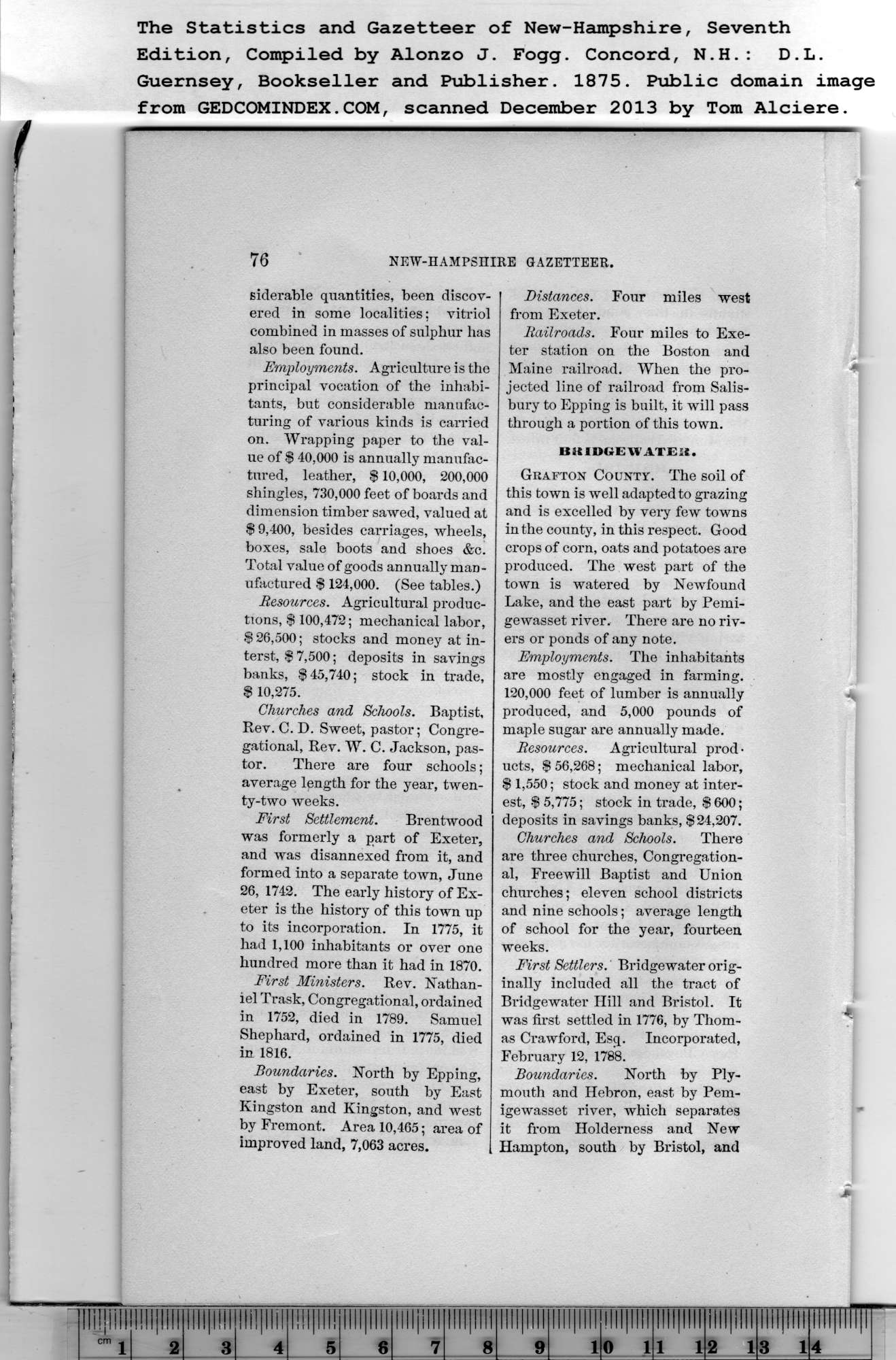|
76
The Statistics and Gazetteer of New-Hampshire, Seventh
Edition, Compiled by Alonzo J. Fogg. Concord, N.H.: D.L.
siderable quantities, been discov-
ered in some localities; vitriol
combined in masses of sulphur has
also been found.
Employments. Agriculture is the
principal vocation of the inhabi-
tants, but considerable manufac-
turing of various kinds is carried
on. Wrapping paper to the val-
ue of $ 40,000 is annually manufac-
tured, leather, $ 10,000, 200,000
shingles, 730,000 feet of boards and
dimension timber sawed, valued at
$ 9,400, besides carriages, wheels,
boxes, sale boots and shoes &c.
Total value of goods annually man-
ufactured $ 124,000. (See tables.)
Resources. Agricultural produc-
tions, $ 100,472; mechanical labor,
$26,500; stocks and money at in-
terst, $ 7,500; deposits in savings
banks, $45,740; stock in trade,
$ 10,275.
Churches and Schools. Baptist,
Rev. C. D. Sweet, pastor; Congre-
gational, Rev. W. C. Jackson, pas-
tor. There are four schools;
average length for the year, twen-
ty-two weeks.
First Settlement. Brentwood
was formerly a part of Exeter,
and was disannexed from it, and
formed into a separate town, June
26, 1742. The early history of Ex-
eter is the history of this town up
to its incorporation. In 1775, it
had 1,100 inhabitants or over one
hundred more than it had in 1870.
First Ministers. Rev. Nathan-
iel Trask, Congregational, ordained
in 1752, died in 1789. Samuel
Shephard, ordained in 1775, died
in 1816.
Boundaries. North by Epping,
east by Exeter, south by East
Kingston and Kingston, and west
by Fremont. Area 10,465; area of
improved land, 7,063 acres. |
Distances. Four miles west
from Exeter.
Railroads. Four miles to Exe-
ter station on the Boston and
Maine railroad. When the pro-
jected line of railroad from Salis-
bury to Epping is built, it will pass
through a portion of this town.
BRIDGEWATER.
Grafton County. The soil of
this town is well adapted to grazing
and is excelled by very few towns
in the county, in this respect. Good
crops of corn, oats and potatoes are
produced. The west part of the
town is watered by Newfound
Lake, and the east part by Pemi-
gewasset river. There are no riv-
ers or ponds of any note.
Employments. The inhabitants
are mostly engaged in farming.
120,000 feet of lumber is annually
produced, and 5,000 pounds of
maple sugar are annually made.
Resources. Agricultural prod •
ucts, $ 56,268; mechanical labor,
$ 1,550; stock and money at inter-
est, $ 5,775; stock in trade, $ 600;
deposits in savings banks, $24,207.
Churches and Schools. There
are three churches, Congregation-
al, Freewill Baptist and Union
churches; eleven school districts
and nine schools; average length
of school for the year, fourteen,
weeks.
First Settlers. Bridgewater orig-
inally included all the tract of
Bridgewater Hill and Bristol. It
was first settled in 1776, by Thom-
as Crawford, Esq. Incorporated,
February 12, 1788.
Boundaries. North by Ply-
mouth and Hebron, east by Pem-
igewasset river, which separates
it from Holderness and New
Hampton, south by Bristol, and |
